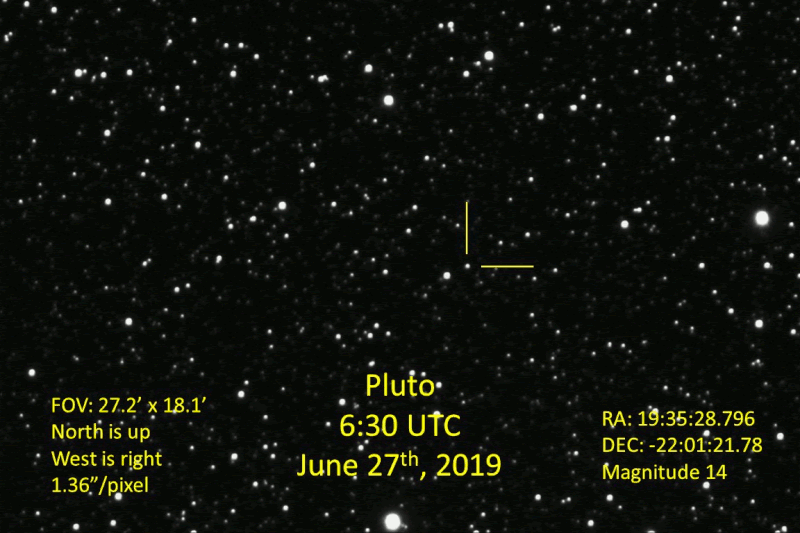

Steven Bellavia in Mattituck, New York, captured Pluto on 2 separate nights, June 24 and June 27. In this animated gif, you can see that Pluto moved in front of the stars between those 2 nights. Steven wrote: “Most of the motion you see is actually from the Earth, not Pluto, since our motion changes our perspective of the much-closer Pluto against the backdrop of the much-farther stars.” Thanks, Steven!
Small icy Pluto – discovered in 1930 – requires a telescope to be seen. It’s some 1,000 times too faint to see with the eye alone. How can you spot it? The only way is to locate Pluto’s starfield through a telescope, and watch over several nights for the object that moves. That’ll be Pluto! It’s seen to move because it’s so much closer to us than the distant stars.
In fact, Pluto is the most distant object in our solar system that can be viewed through amateur telescopes.
And the best time of year to see Pluto through a small telescope is here! The planet will reach its opposition on July 14, 2019. At opposition, Pluto appears more or less opposite the sun in our sky, rising in the east as the sun sets in the west. At this time, our planet Earth is passing approximately between Pluto and the sun; we aren’t going directly between Pluto and the sun this year as we did in 2018. Also, don’t let that opposition date – July 14 – fool you. Pluto is visible somewhere in the sky, for some hours of the night, for most of every year. July 14 just marks the middle of the best time of year to see it.
Here are few tips for spotting Pluto in 2019:
– You’ll need at least an 8-inch telescope. A 12-inch telescope – like the one used by Efrain Morales to capture the image at the bottom of this post – will capture even more light from this distant world.
– You’ll want dark, clear, country skies. Visit EarthSky’s Best Places to Stargaze page for dark locations near you.
– Pluto is traveling in front of the constellation Sagittarius this year, as seen from Earth.
Pluto as seen with a 12″ S/C telescope (14.3 mag.) on July 10, 2015. Photo by Efrain Morales, of Sociedad de Astronomia del Caribe. More information about Pluto’s current location.
Bottom line: The only way to spot it is to locate Pluto’s starfield through a telescope, and watch over several nights for the object that moves. That’ll be Pluto. Over the weeks following its opposition, Pluto will rise four minutes earlier each night. That means it’ll be in the east at sundown, setting before dawn, by August. Finding it requires patience and a telescope! But it’s very satisfying to see Pluto with your own eyes.
from EarthSky https://ift.tt/2XkisVG


Steven Bellavia in Mattituck, New York, captured Pluto on 2 separate nights, June 24 and June 27. In this animated gif, you can see that Pluto moved in front of the stars between those 2 nights. Steven wrote: “Most of the motion you see is actually from the Earth, not Pluto, since our motion changes our perspective of the much-closer Pluto against the backdrop of the much-farther stars.” Thanks, Steven!
Small icy Pluto – discovered in 1930 – requires a telescope to be seen. It’s some 1,000 times too faint to see with the eye alone. How can you spot it? The only way is to locate Pluto’s starfield through a telescope, and watch over several nights for the object that moves. That’ll be Pluto! It’s seen to move because it’s so much closer to us than the distant stars.
In fact, Pluto is the most distant object in our solar system that can be viewed through amateur telescopes.
And the best time of year to see Pluto through a small telescope is here! The planet will reach its opposition on July 14, 2019. At opposition, Pluto appears more or less opposite the sun in our sky, rising in the east as the sun sets in the west. At this time, our planet Earth is passing approximately between Pluto and the sun; we aren’t going directly between Pluto and the sun this year as we did in 2018. Also, don’t let that opposition date – July 14 – fool you. Pluto is visible somewhere in the sky, for some hours of the night, for most of every year. July 14 just marks the middle of the best time of year to see it.
Here are few tips for spotting Pluto in 2019:
– You’ll need at least an 8-inch telescope. A 12-inch telescope – like the one used by Efrain Morales to capture the image at the bottom of this post – will capture even more light from this distant world.
– You’ll want dark, clear, country skies. Visit EarthSky’s Best Places to Stargaze page for dark locations near you.
– Pluto is traveling in front of the constellation Sagittarius this year, as seen from Earth.
Pluto as seen with a 12″ S/C telescope (14.3 mag.) on July 10, 2015. Photo by Efrain Morales, of Sociedad de Astronomia del Caribe. More information about Pluto’s current location.
Bottom line: The only way to spot it is to locate Pluto’s starfield through a telescope, and watch over several nights for the object that moves. That’ll be Pluto. Over the weeks following its opposition, Pluto will rise four minutes earlier each night. That means it’ll be in the east at sundown, setting before dawn, by August. Finding it requires patience and a telescope! But it’s very satisfying to see Pluto with your own eyes.
from EarthSky https://ift.tt/2XkisVG

Aucun commentaire:
Enregistrer un commentaire